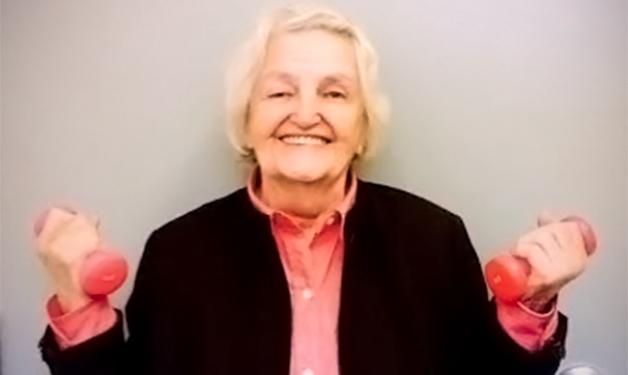
“I say yes because if there’s no research involving people, you can’t cure anything.”
— Eileen Curtis, Vancouver
For 84-year-old Vancouver resident Eileen Curtis, walking and talking at the same time has become something of a hazard. Four years ago, she took a bad spill on the sidewalk doing just that. But it wasn’t until she participated in Action Seniors—a clinical trial funded by the Canadian Institutes of Health Research for older adults at high risk for falling—that she learned that looking to either side of her while walking and talking makes her lose her balance.
“I have a half-paralyzed leg from a stroke—I had been falling already,” she says. “But for the first time ever in my life, I fell and was completely knocked out and needed an ambulance.”
The incident prompted her youngest daughter to suggest Curtis visit the Falls Prevention Clinic, a referral-based clinic jointly supported by Vancouver Coastal Health Research Institute (VCHRI), the University of British Columbia, and the Centre for Hip Health and Mobility. Action Seniors is being conducted through the clinic to investigate whether a home-based exercise program could significantly reduce falls among older adults at higher risk, such as Curtis.
“The researchers had me walk with one of them and then turn my head to talk to them and immediately I started to trip–that was one discovery,” Curtis explains. “So, they said that if I’m walking beside someone and want to talk to them, that I need to still look ahead and not at the person. I found that very helpful.”
Dr. Teresa Liu-Ambrose, VCHRI researcher and principal investigator for Action Seniors, explains that once a fall happens, the risk for subsequent falls increases, and potentially with more harmful consequences.
“At some point, if nothing is done to address an older adult’s falls, the likelihood of a fall-related catastrophe is high—for example, 90 per cent of all hip fractures are due to a fall–or it gets to the point where they lose sufficient mobility and self-confidence that they no longer can, or want to, live in their own homes,” says Dr. Liu-Ambrose, director of research and operations at the Falls Prevention Clinic.

Action Seniors aims to demonstrate a very feasible approach to reducing falls among high-risk older adults by evaluating and showing the breadth of impact exercise could have across a multitude of conditions.
“Falls are multi-factorial—there’s rarely just one cause—and exercise has multi-factorial benefits as well,” she says. “For example, impaired cognitive function and physical abilities are key risk factors for falls. The evidence strongly suggests that exercise targets both primary risk components; it positively influences your brain health and improves muscle strength and balance.”
Dr. Liu-Ambrose invites older adults to participate in the clinical trial if only to receive exceptional, comprehensive care. In addition, the study has half of the participants receiving a home-based, individualized exercise program delivered by a physiotherapist who has knowledge of their physical capacities, abilities, and any other relevant medical conditions.
“We really do adopt the most evidence-based approaches in our assessments and we have fabulous geriatricians who are great clinicians working as part of our team,” Dr. Liu-Ambrose says. “We are genuinely trying to tap into why a person is falling. For example, we do a comprehensive cognitive assessment because the evidence suggests that even mild changes in cognition can increase the risk of falling.”
Action Seniors aims to enroll 344 older adults; 280 have been recruited to date. To qualify for the clinical trial, participants must be over the age of 70 and must have sought medical attention previously because of a fall.
Although initially Curtis wasn’t sure about participating in the study, she is very pleased that she enrolled. And since learning about the causes of her falls, she has not fallen again.
“I’d never been in such a thing before in my life and I found it very interesting,” says Curtis. “And they were so helpful; it didn’t matter what questions I asked the clinicians and researchers, they would answer me.”
Curtis now walks with a cane that she jokingly describes as a “weapon” because of its large claw-like foot that keeps her steady. And now, when talking and walking, she has much to look forward to by only looking straight ahead.


